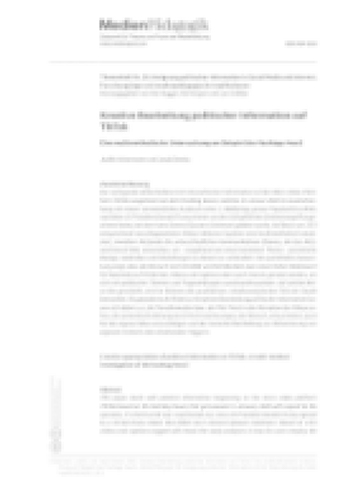Abstract
Continuing vocational education and training is now also taking place online. Often, however, the pedagogical value of digital media for job-related learning remains unclear: on the one hand, there is the chance of independent use of learning resources; on the other hand, it is questionable whether and how digital tools can support processes of meaning making and reflection. In this article, we look at this educational question and, using two examples from informal learning contexts – Twitter and YouTube – describe why and how digital media here supports job-related learning. We reflect these empirically found learning forms with reference to the network metaphor, the theory of situated cognition (Resnick et al. 1997, Lave/Wenger 1999, Fox 2000) and the knowledge building approach (Scardamalia/Bereiter 2014). These considerations lead to broader, critical-reflective media literacy concept for vocational education of specialists. We want to empower craftsmen and professionals to cross the boundaries of formal training, to participate in social media interest groups and to shape amorphous vocational education settings.References
Ball, Claudia. 2013. «Berufliche Aus- und Weiterbildung und Lebenslanges Lernen von Berufskraftfahrern: Chancen und Risiken einer europaweiten Pflicht zur regelmässigen Weiterbildung». bwp@ Spezial 6 – Hochschultage Berufliche Bildung, 1-19. http://www.bwpat.de/ht2013/ft08/ball_ft08-ht2013.pdf.
Bundesverband betriebliche Weiterbildung (2016). Trendstudie des Wuppertaler Kreis e.V. http://www.wkr-ev.de.
Burchert, Joanna. 2014. Von der Facharbeit in die Ausbildung: Empirische Studie und theoretischer Rahmen zur Erforschung des pädagogischen Selbstverständnisses hauptamtlicher Ausbilder und Ausbilderinnen. Dissertation an der Universität Bremen. http://elib.suub.uni-bremen.de/edocs/00104110-1.pdf.
Burchert, Joanna, und Rasmus Grobe. 2017. «Herausforderungen bei der Implementierung digital gestützter beruflicher Weiterbildung. Die Sicht von WeiterbildnerInnen und BildungsmanagerInnen auf Strukturen, kulturelle Praktiken und Agency». Magazin erwachsenenbildung.at Das Fachmedium für Forschung, Praxis und Diskurs, 30. http://www.erwachsenenbildung.at/magazin/17-30/meb17-30.pdf.
Fenwick, Tara, und Richard Edwards. 2010. Actor-Network Theory in Education. London: Routledge.
Freire, Paolo. 2001. Pedagogy of Freedom: Ethics, Democracy, and Civic Courage. Lanham: Rowman and Littlefeld.
Fox, Stephen. 2000. «Communities Of Practice, Foucault And Actor-Network Theory». Journal of Management Studies 37- 6, 853–868. http://onlinelibrary.wiley.com/doi/10.1111/1467-6486.00207/full.
Hattie, John. 2009. Visible learning. A synthesis of over 800 meta-analyses relating to achievement. London, New York: Routledge.
Hart, Jane. 2016. Top Tools for Learning 2016. http://c4lpt.co.uk/top100tools/top-200-tools-for-learning/.
Jörissen, Benjamin. 2013. «Unbestellte Bildungsfelder – wo bleiben die neuen Formate der Erwachsenen- und Weiterbildung?» Forum Erwachsenenbildung, Nr. 2: 16–21.
Kade, Jochen, und Wolfgang Seitter. 1996. Lebenslanges Lernen - mögliche Bildungswelten: Erwachsenenbildung, Biographie und Alltag. Opladen: Leske + Budrich.
Köster, M. 2003. «Warum Training selten funktioniert: Über die Notwendigkeit von soziologischer Perspektive in einer boomenden Branche». Sozialwissenschaften und Berufspraxis (SuB) 26, 255-267.
Larbig, Torsten, und André Spang, Hrsg. 2017. Digitale Medien für Unterricht, Lehrerjob und Schule: die besten Ideen und Tipps aus dem Twitterchat #EDchatDE. 1. Auflage. Berlin: Cornelsen. https://news.rpi-virtuell.de/wp-content/uploads/2017/02/digitale-medien-fur-unterricht.pdf.
Lave, Jean, und Etienne Wenger. 1999. Situated learning. Legitimate peripheral participation. Cambridge.
Podrath, Gudrun. 2016. Lernen mit Youtube. https://www.haufe.de/personal/hr-management/e-learning-lernen-mit-youtube_80_380714.html
Resnick, Lauren B., Clothilde Pontecorvo, und Roger Saljö. 1997. «Discourse, tools and reasoning». In Discourse, tools and reasoning: Essays on situated cognition, hrsg. von Lauren B. Resnick, Roger Saljö, Clothilde Pontecorvo und Barbara Burge, 1-22. Berlin u.a.: Springer.
Scardamalia, Marlene, und Carl Bereiter. 2014. «Smart technology for self-organizing processes». Smart Learning Environments 1:1, http://slejournal.com/content/1/1/1.
von Rein, Nuissl im Interview mit Ion Dumitru. 2000. Erwachsene lernen anders. http://www.die-frankfurt.de/esprid/dokumente/doc-2000/dumitru00_01.htm.
Wolf, Gertrud. 2016. «Learning by YouTube. Was macht die Video-Plattform als informelles Lernangebot so erfolgreich?». Erwachsenenbildung 62, Heft 2, 62–64.

